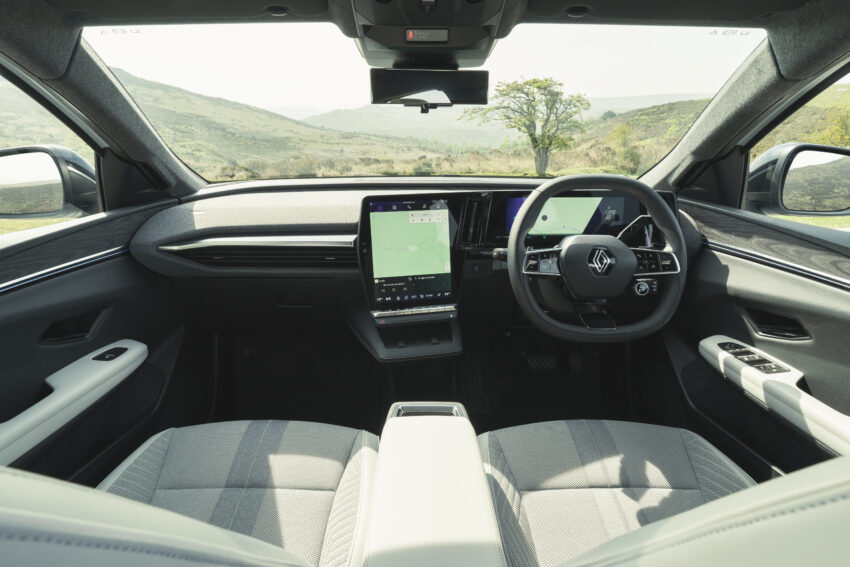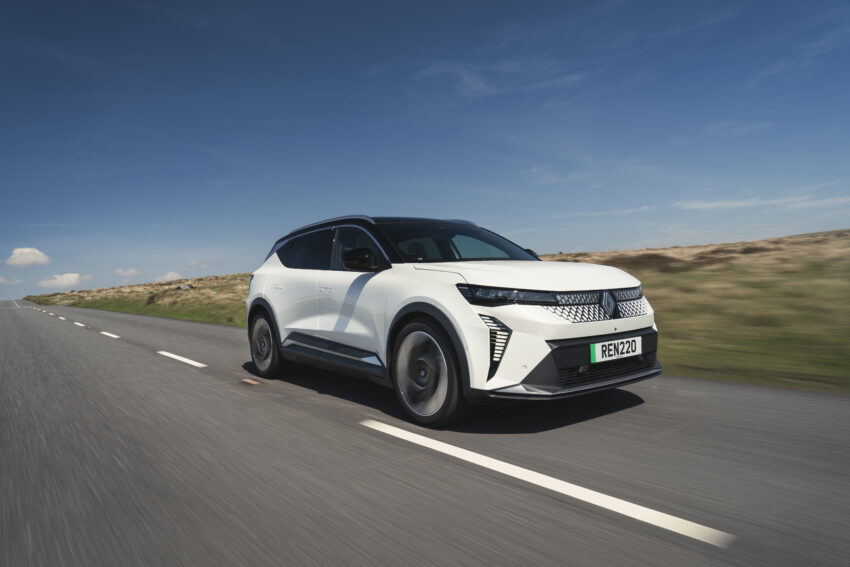2024 Renault Scenic E-Tech review: A family SUV packed with practical touches
Does this new take on the famous Renault Scenic name still have the family friendly flexibility of the original?
The Renault Scenic was a groundbreaking car when it was launched in 1996 (complete with ‘Megane’ in its name). It was the very first compact MPV and started a trend for cars that offered the flexibility of the Espace or Ford Galaxy but in a smaller, more manageable package.
However, MPVs have fallen out of fashion and the Scenic was killed off in 2022 as Renault turned its focus to crossovers and SUVs. But now the name’s back and attached to an all-electric model.
Reimagined as a SUV (predictably) but with the same basic aim of providing practical and flexible family motoring, Renault’s vision for the Scenic E-Tech is ‘a family car with fun and tech’ that just happens to be electric.
So how does it stack up with the likes of the Volkswagen ID.4, Skoda Enyaq and Peugeot E-3008?
Design, interior and technology
Renault’s designers have done a good job of giving the Scenic some character in a segment where there’s a tendency for many cars to look very similar.
It’s not groundbreaking but the sharply folded front end is distinctive, especially thanks to the neat hexagon motif that fades into the bodywork as it radiates out from the new-look badge. The sharp creases extend to the low-level arrow-like running lights and along the doors but behind the bold face you could be looking at any number of C-segment SUVs.
Inside, there’s also a degree of familiarity thanks to a layout largely shared with the Megane and Austral. There’s a L-shaped arrangement of screens tilted towards the driver, with sensible physical controls under the 12-inch portrait touchscreen. The low-set dashboard sweeps nicely into the door tops and in top-spec cars there’s a tactile wood insert along with visually pleasing but perhaps not child-friendly pale fabric upholstery.

One thing that’s immediately different from the old Scenic is that the E-Tech has a regular 60/40 split rear bench rather than three individual rear seats. It’s a shame because, as any parent of more than two kids will tell you, three proper rear seats are a real bonus in a family car.
Nonetheless, the rear of the cabin is pretty spacious and three youngsters will fit across the bench easily enough. There’s plenty of legroom too, even for very tall adults, who will also appreciate the generous headroom allowed by the clever Solarbay sunroof. This neat feature uses ingenious liquid crystals technology instead of a mechanical blind to save headroom and weight (around 8kg), and allows you to turn the glass from clear to opaque across various zones at the touch of a button or using a brief voice command.
Weirdly, the rear armrest is a small but significant area that shows Renault’s designers have really thought about how families use cars these days. Hidden away in it are two USB ports, cable routing, cupholders and flip-out arms that will hold two mobile phones or one larger tablet. Other touches such as a deep, open centre console, multiple seatback pockets for devices, bottles and snacks and a 545-litre boot hint at a design team all too aware of a family’s motoring needs.
The segment-first sunroof is among the Scenic’s technological highlights but there are other smart features. The multimedia screen uses Google’s OS and has a simple, easy to use layout. There are lots of apps – from Spotify to video streaming – available through the Google Store but one of the most useful is Google Maps. Because it’s native to the car, this integrates battery conditioning – normally reserved for a cars’ built-in nav system – into Google’s exemplary route planning.
Also earning a big tick from me is the simple button that lets you save personalised ADAS settings and apply them with one touch every time you start the car.
Less important but still pleasingly French is the car’s pedestrian warning sound developed by synth legend Jean-Michel Jarre.
Battery, motor and performance
There are two powertrain options in the Scenic E-Tech, with different motor and battery pairings.
The cheaper Comfort Range features a 168bhp motor and a 60kWh battery offering 260 miles of range. Meanwhile Long Range – the only one I’ve tested so far – gets a 217bhp motor and an 87kWh unit that offers an impressive 379 miles on a full charge. Even allowing for cold days and unsympathetic driving, the Scenic should do well over 300 miles on a charge – more than most families will manage without at least one little cherub needing to stop to pee/puke/eat/all of the above.
Officially, Renault says the long-range car does an average of 3.6m/kWh but on a warm day across a variety of roads, speeds and driving modes, I got a pleasing 3.8m/kWh.
That’s possibly because the Scenic doesn’t ask to be driven enthusiastically. It drives in a similar way to any number of other C-segment SUVs – predictable, secure and lifeless, with various drive modes that do little to change the feel of proceedings. The steering is a little quicker than some alternatives but, in typical Renault fashion, overly assisted and light. That doesn’t do much for the drive but makes urban manoeuvres a piece of cake.
One noticeable difference to rivals is that the Scenic has a firmer ride and an unwelcome sharpness over road imperfections such as potholes. It’s not a deal breaker but the Scenic doesn’t feel as composed or compliant as an Enyaq or Niro.
Alongside the impressive range and efficiency, the Scenic features 150kW charging (130kW in the ‘comfort’ cars) and a heat pump as standard on all models, so you can add up to 209 miles of charge in half an hour.
Price and specification
Renault is keeping things blessedly simple with the Scenic range. There are no options or add-on packs, so the only decisions to be made are around the colour and which of three trims and two powertrains you want.
The range starts at £37,495 for the comfort range techno trim. You can upgrade the battery for £3,500, or move up to esprit Alpine spec which costs £43,495 and comes with the beefier drivetrain as standard.
All versions come with 19-inch alloy wheels, the 12-inch infotainment display, 12.3-inch digital instruments, wireless phone charging and mirroring, a power tailgate, heated seats and steering wheel, and full LED lighting.
The esprit Alpine is largely a cosmetic upgrade, with bespoke badging, 20-inch wheels, sports seats and a blue-hued interior finish.
Iconic costs £45,495 and brings more significant upgrades including the clever sunroof, pale interior with wood inserts, a Harman Kardon sound system, driver’s seat massage function and hands-free parking with a 360-degree camera.
Verdict
In a couple of ways the new Scenic is unremarkable. It looks good but not spectacular, and drives as well as key rivals but no better.
However, it is an exceedingly well thought out car that nails the brief of a ‘family car that just happens to be electric’.
There’s heaps of space for passengers and luggage, useful touches like the multi-function armrest, clever technology and a range that will outlast most parents’ patience, meaning it will tick a lot of boxes for an awful lot of people.
Renault Scenic E-Tech iconic
Price: £45,495
Powertrain: single-motor, front-wheel-drive
Battery: 87kWh usable
Power: 217bhp
Torque: 221lb ft
Top speed: 105mph
0-62mph: 7.9 seconds
Range: 379 miles
Consumption: 3.6m/kWh
Charging: up to 150kW



